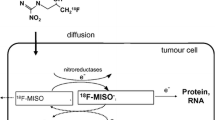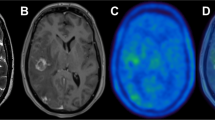Abstract
Purpose
Hypoxia is important in the biology of glioma in humans. Positron emission tomography/computed tomography (PET/CT) with a hypoxia tracer offers a noninvasive method to differentiate individual tumor biology and potentially modify treatment for patients with malignancies. The purpose of this study was to determine whether hypoxia, as measured by fluorine-18 fluoroerythronitroimidazole (18F-FETNIM) PET/CT, was associated with tumor grade, overall survival (OS), and immunohistochemical features related to hypoxia, proliferation, angiogenesis, and the invasion of gliomas.
Procedures
Twenty-five patients with gliomas in whom gross maximal resection could be safely attempted were analyzed. All patients underwent 18F-FETNIM PET/CT studies before surgery. The maximum standardized uptake value (SUVmax) was obtained from the PET images of tumor tissues. Tumor specimens were stereotactically obtained for the immunohistochemical staining of hypoxia-inducible factor-1 alpha (HIF-1α), Ki-67, vascular endothelial growth factor (VEGF), and matrix metalloproteinase 9 (MMP-9).
Results
A correlation between the SUVmax and glioma grade was found (r = 0.881, P < 0.001). The SUVmax was significantly correlated with the expression of HIF-1α, Ki-67, VEGF, and MMP-9 (r = 0.820, 0.747, 0.606, and 0.727; all P < 0.001). Patients with a high SUVmax had significantly worse 3-year OS than those with a low SUVmax (24.4% vs. 82.1%, P = 0.003).
Conclusions
18F-FETNIM PET/CT provides an excellent noninvasive assessment of hypoxia in glioma. It can be used to understand the mechanisms by which hypoxia affects the OS of glioma patients.




Similar content being viewed by others
References
Ries LAG, Eisner MP, Kosary CL, et al. SEER cancer statistics review, 1975–2001. National Cancer Institute; Bethesda: 2004. [Accessed July 26, 2018].
Hu M, Xing L, Mu D, et al. Hypoxia imaging with 18F-fluoroerythronitroimidazole integrated positron emission tomography and computed tomography and immunohistochemical studies in non-small-cell lung cancer. Clin Nucl Med. 2013;38:591–6.
Chatterjee A, Gupta T, Rangarajan V, et al. Optimal timing of fluorine-18-fluoromisonidazole positron emission tomography/computed tomography for assessment of tumor hypoxia in patients with head and neck squamous cell carcinoma. Nucl Med Commun. 2018;39:859–64.
Mapelli P, Zerbetto F, Incerti E, et al. 18F-FAZA PET/CT hypoxia imaging of high-grade glioma before and after radiotherapy. Clin Nucl Med. 2017;42:e525–6.
Zegers CM, Hoebers FJ, van Elmpt W, et al. Evaluation of tumour hypoxia during radiotherapy using [18F]HX4 PET imaging and blood biomarkers in patients with head and neck cancer. Eur J Nucl Med Mol Imaging. 2016;43:2139–46.
Lopci E, Grassi I, Rubello D, et al. Prognostic evaluation of disease outcome in solid tumors investigated with 64Cu-ATSM PET/CT. Clin Nucl Med. 2016;41:e87–92.
Shibahara I, Kumabe T, Kanamori M, et al. Imaging of hypoxic lesions in patients with gliomas by using positron emission tomography with 1-(2-[18F] fluoro-1-[hydroxymethyl]ethoxy)methyl-2-nitroimidazole, a new 18F-labeled 2-nitroimidazole analog. J Neurosurg. 2010;113(2):358–68.
Cher LM, Murone C, Lawrentschuk N, et al. Correlation of hypoxic cell fraction and angiogenesis with glucose metabolic rate in gliomas using 18F-fluoromisonidazole, 18F-FDG PET, and immunohistochemical studies. J Nucl Med. 2006;47:410–08.
Yamamoto Y, Maeda Y, Kawai N, et al. Hypoxia assessed by 18F-fluoromisonidazole positron emission tomography in newly diagnosed gliomas. Nucl Med Commun. 2012;33:621–5.
Kanoto M, Kirii K, Hiraka T, et al. Correlation between hypoxic area in primary brain tumors and WHO grade: differentiation from malignancy using 18F-fluoromisonidazole positron emission tomography. Acta Radiol. 2018;59:229–35.
Hirata K, Terasaka S, Shiga T, et al. 18F-Fluoromisonidazole positron emission tomography may differentiate glioblastoma multiforme from less malignant gliomas. Eur J Nucl Med Mol Imaging. 2012;39:760–70.
Bekaert L, Valable S, Lechapt-Zalcman E, et al. [18F]-FMISO PET study of hypoxia in gliomas before surgery: correlation with molecular markers of hypoxia and angiogenesis. Eur J Nucl Med Mol Imaging. 2017;44:1383–92.
Grönroos T, Bentzen L, Marjamäki P, et al. Comparison of the biodistribution of two hypoxia markers [18F]FETNIM and [18F]FMISO in an experimental mammary carcinoma. Eur J Nucl Med Mol Imaging. 2004;31:513–20.
Yang DJ, Wallace S, Cherif A, et al. Development of F-18-labeled fluoroerythronitroimidazole as a PET agent for imaging tumor hypoxia. Radiology. 1995;194:795–800.
Li L, Hu M, Zhu H, et al. Comparison of 18F-fluoroerythronitroimidazole and 18F-fluorodeoxyglucose positron emission tomography and prognostic value in locally advanced non-small-cell lung cancer. Clin Lung Cancer. 2010;11:335–40.
Yue J, Yang Y, Cabrera AR, et al. Measuring tumor hypoxia with 18F-FETNIM PET in esophageal squamous cell carcinoma: a pilot clinical study. Dis Esophagus. 2012;25:54–61.
Grönroos T, Eskola O, Lehtiö K, et al. Pharmacokinetics of [18F]FETNIM: a potential marker for PET. J Nucl Med. 2001;42:1397–13404.
Xue S, Hu M, Li P, et al. Relationship between expression of PD-L1 and tumor angiogenesis, proliferation, and invasion in glioma. Oncotarget. 2017;8:49702–12.
Lehtio K, Oikonen V, Nyman S, et al. Quantifying tumour hypoxia with fluorine-18 fluoroerythronitroimidazole ([18F]FETNIM) and PET using the tumour to plasma ratio. Eur J Nucl Med Mol Imaging. 2003;30:101–8.
Kaur B, Khwaja FW, Severson EA, et al. Hypoxia and the hypoxia-inducible-factor pathway in glioma growth and angiogenesis. Neuro-Oncology. 2005;7:134–53.
Kawai N, Lin W, Cao WD, et al. Correlation between 18F-fluoromisonidazole PET and expression of HIF-1alpha and VEGF in newly diagnosed and recurrent malignant gliomas. Eur J Nucl Med Mol Imaging. 2014;41:1870–8.
Spence AM, Muzi M, Swanson KR, et al. Regional hypoxia in glioblastoma multiforme quantified with [18F]fluoromisonidazole positron emission tomography before radiotherapy: correlation with time to progression and survival. Clin Cancer Res. 2008;14:2623–30.
Funding
This study was funded by the Science Technology Program of Jinan (201805051) and the Key Research Development Program of Shandong Province (2019GGX101057).
Author information
Authors and Affiliations
Corresponding author
Ethics declarations
Conflict of interest
The authors declare that they have no conflict of interest.
Ethical approval
All procedures performed in studies involving human participants were in accordance with the ethical standards of the institutional and/or national research committee and with the 1964 Helsinki Declaration and its later amendments or comparable ethical standards. This article does not contain any studies with animals performed by any of the authors.
Informed consent
Informed consent was obtained from all individual participants included in the study.
Additional information
Publisher’s note
Springer Nature remains neutral with regard to jurisdictional claims in published maps and institutional affiliations.
The current study received the Merit Award at the 2014 American Society of Clinical Oncology (ASCO) Annual Meeting in an Oral Scientific Session on June 2, 2014, Chicago, Illinois, USA.
This article is part of the Topical Collection on Oncology – Brain
Electronic supplementary material
ESM 1
(JPG 288 kb)
Rights and permissions
About this article
Cite this article
Hu, M., Zhu, Y., Mu, D. et al. Correlation of hypoxia as measured by fluorine-18 fluoroerythronitroimidazole (18F-FETNIM) PET/CT and overall survival in glioma patients. Eur J Nucl Med Mol Imaging 47, 1427–1434 (2020). https://doi.org/10.1007/s00259-019-04621-z
Received:
Accepted:
Published:
Issue Date:
DOI: https://doi.org/10.1007/s00259-019-04621-z




